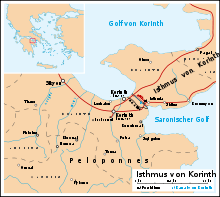Phlius
Phlius or Phlious or Phleious (/ˈflaɪəs/; Ancient Greek: Φλιοῦς or Φλειοῦς) was an independent polis (city-state) in the northeastern part of Peloponnesus. Phlius' territory, called Phliasia (Φλιασία), was bounded on the north by Sicyonia, on the west by Arcadia, on the east by Cleonae, and on the south by Argolis. This territory is a small valley about 900 feet (270 m) above the level of the sea, surrounded by mountains, from which streams flow down on every side, joining the river Asopus in the middle of the plain. The mountain in the southern part of the plain, from which the principal source of the Asopus springs, was called Carneates (Καρνεάτης).[1] The territory of Phlius was celebrated in antiquity for its wine.[2] According to Strabo, the ancient capital of the country was Araethyrea (Ἀραιθυρέα) on Mt. Celosse,[3] which city is mentioned by Homer;[4] but the inhabitants subsequently deserted it and built Phlius at the distance of 30 stadia. Pausanias, however, does not speak of any migration, but says that the ancient capital was named Arantia (Ἀραντία), from its founder Aras, an autochthon, that it was afterwards called Araethyrea from a daughter of Aras, and that it finally received the name of Phlius, from Phlias, a son of Ceisus and grandson of Temenus.[5] The name of Arantia was retained in the time of Pausanias in the hill Arantinus, on which the city stood. Hence the statement of grammarians that both Arantia and Araethyrea were ancient names of Phlius.[6][7] According to Stephanus of Byzantium, Phlius derived its name from Dionysus and Chthonophyle.[8] Phlius was subsequently conquered by Dorians under Rhegnidas, who came from Sicyon. Some of the inhabitants migrated to Samos, others to Clazomenae; among the settlers at Samos was Hippasus, from whom Pythagoras derived his descent.[9]

Like most of the other Doric states, Phlius was governed by an aristocracy, though it was for a time subject to a tyrant Leon, a contemporary of Pythagoras.[10] Phlius sent 200 soldiers to the Battle of Thermopylae,[11] and 1000 to the Battle of Plataea.[12] Although geographically close to Argos, it was an ally of Sparta and a member of the Peloponnesian League. During the whole of the Peloponnesian War it remained faithful to Sparta and hostile to Argos.[13]
References
- Strabo. Geographica. viii. p.382. Page numbers refer to those of Isaac Casaubon's edition.
- Athen. 1.27d.
- Strabo. Geographica. viii. p.382. Page numbers refer to those of Isaac Casaubon's edition.
- Homer. Iliad. 2.571.
- Pausanias. Description of Greece. 2.12.4. -5.
- Stephanus of Byzantium. Ethnica. s. vv. Φλιοῦς, Ἀραντία.
- Schol. ad Apoll. Rhod. 1.115.
- Stephanus of Byzantium. Ethnica. s.v. Φλιοῦς.
- Pausanias. Description of Greece. 2.13.1. , et seq.
- Diogenes Laërtius 1.12, 8.8; Cicero Tusc. 5.3
- Herodotus. Histories. 7.202.
- Herodotus. Histories. 9.28.
- Thucydides. History of the Peloponnesian War. 5.57, et seq., 6.105.
- Legon, Ronald P. "Phliasian Politics and Policy in the Early Fourth Century B.C." Historia: Zeitschrift Für Alte Geschichte 16, no. 3 (1967): 324-37. http://www.jstor.org/stable/4434991.
- Legon, Ronald P. "Phliasian Politics and Policy in the Early Fourth Century B.C." Historia: Zeitschrift Für Alte Geschichte 16, no. 3 (1967): 324-37. http://www.jstor.org/stable/4434991.
- Xenophon. Hellenica. 4.4.15, et seq.
- Xenophon. Hellenica. 5.2.8, et seq.
- Xenophon. Hellenica. 5.3.10, et seq.
- Plutarch Ages. 24; Diodorus Siculus. Bibliotheca historica (Historical Library). 15.20.
- Xenophon. Hellenica. 7.2.1.
- Xenophon. Hellenica. 7.2.5-9.
- Xenophon. Hellenica. 7.2.11 et seq.
- Polybius. The Histories. 2.44.
- Pausanias. Description of Greece. 2.13.6.
- Pausanias. Description of Greece. 2.13.3. , et seq.
- Lund University. Digital Atlas of the Roman Empire.
- Richard Talbert, ed. (2000). Barrington Atlas of the Greek and Roman World. Princeton University Press. p. 58, and directory notes accompanying.
![]()
Sources
- Fine, John V.A. The Ancient Greeks: A critical history (Harvard University Press, 1983) ISBN 0-674-03314-0
- Xenophon (1890s) [original 4th century BC]. . Translated by Henry Graham Dakyns – via Wikisource.